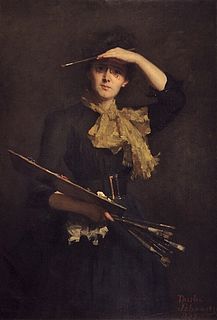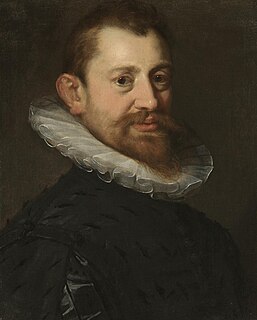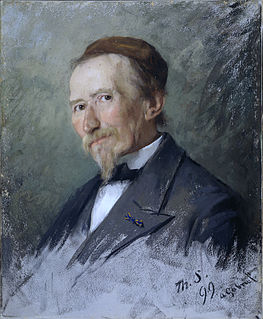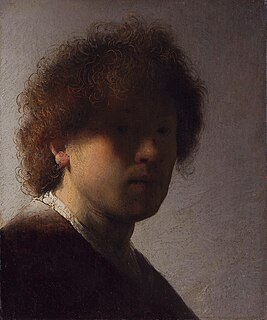
Huis ten Bosch is a royal palace in The Hague, Netherlands. It is one of three official residences of the Dutch monarch; the two others being the Noordeinde Palace in The Hague and the Royal Palace in Amsterdam.

Thérèse Schwartze was a Dutch portrait painter.

Johan Barthold Jongkind was a Dutch painter and printmaker. He painted marine landscapes in a free manner and is regarded as a forerunner of Impressionism.

Adriaen de Vries (c.1556–1626) was a Northern Mannerist sculptor born in the Netherlands but working in Central Europe, whose international style crossed the threshold to the Baroque; he excelled in refined modelling and bronze casting and in the manipulation of patina and became the most famous European sculptor of his generation. He also excelled in draughtsmanship.

Artus Quellinus also known as Artus (Arnoldus) Quellijn, Artus Quellinus I or Artus Quellinus the Elder was a Flemish sculptor. He is regarded as the most important representative of the Baroque in sculpture in the Southern Netherlands. His work had a major influence on the development of sculpture in Northern Europe.
Willem Danielsz. van Tetrode, known in Italy as Guglielmo Fiammingo, was a sixteenth-century sculptor of Dutch origin who served as a pupil of Benvenuto Cellini in Florence. On his return to Delft in the Netherlands in 1567-68, it has been suggested that he may have trained the young Adriaen de Vries and encouraged him to go to Florence.

Rombout Verhulst was a Flemish sculptor and draughtsman who spent most of his career in the Dutch Republic. There he helped introduce the Baroque style in sculpture while becoming the leading sculptor of marble monuments, including funerary monuments, garden figures and portraits.

JohanGregor van der Schardt was a sculptor from the Northern Renaissance.

Paul Joseph Constantin Gabriël or Paul Gabriël was a painter, draftsman, watercolorist, and etcher who belonged to the Hague School.

Ewerdt Hilgemann is a German artist, currently living and working in the Netherlands.

Lambertus (Bert) Nienhuis was a Dutch ceramist, designer and jewelry designer.

Gothic boxwood miniatures are very small Christian wood sculptures produced during the 15th and 16th centuries in the Low Countries, at the end of the Gothic period and during the emerging Northern Renaissance. They consist of highly intricate layers of reliefs, often rendered to nearly microscopic level, and are made from boxwood, which has a fine grain and high density suitable for detailed micro-carving. There are around 150 surviving examples; most are spherical rosary beads, statuettes, skulls, or coffins; some 20 are in the form of polyptychs, including triptych and diptych altarpieces, tabernacles and monstrances. The polyptychs are typically 10–13 cm in height. Most of the beads are 10–15 cm in diameter and designed so they could be held in the palm of a hand, hung from necklaces or belts, or worn as fashionable accessories.

Prayer nuts, or Prayer beads are very small 16th century small Gothic boxwood miniature sculptures, mostly originating from the north of today's Holland. They are typically detachable and open into halves of highly detailed and intrinsic Christian religious scenes. Their size varies between the size of a walnut and a golf ball. They are mostly the same shape, decorated with carved openwork Gothic tracery and flower-heads. Most are 2–5 cm in diameter and designed so they could be held in the palm of a hand during personal devotion or hung from necklaces or belts as fashionable accessories.

Petronella Dunois (1650–1695) was a Dutch art collector, known for her dollhouse in the Rijksmuseum in Amsterdam.

Adam Dircksz is the name ascribed by some art historians to a highly influential Dutch sculptor whose workshop is often attributed with the creation of around 60 of the c. 150 extant Gothic boxwood miniature micro-carvings. Other historians prefer to attribute various unrelated artists who are given individual or grouped notnames. It may be that the master was the innovator in this style of sculpture, and that similar works were directly inspired. According to the British Museum, Dircksz may have served "elite patrons in the circle of the Holy Roman Emperor Charles V, with a strong link to Delft."

Half of a Prayer Bead with the Lamentation, refers to a pair of Gothic boxwood miniature medallions originating from Flanders around the early 16th century, probably between 1490-1530. Made from boxwood and silver, they were originally the interiors of a prayer nut.

The miniature altarpiece in the British Museum, London is a very small portable Gothic boxwood sculpture which was completed in 1511 by a Northern Netherlands master sometimes identified as Adam Dircksz, and members of his workshop. At 25.1 cm (9.9 in) high, it is built from a series of architectural layers or registers, which culminate at an upper triptych, whose center panel contains a minutely detailed and intricate Crucifixion scene filled with multitudes of figures in relief. Its outer wings show Christ Carrying the Cross on the left, and the Resurrection on the right.
The Adoration of the Magi altarpiece is a small Gothic boxwood miniature, made in the Netherlands c.1500–1530, attributed to the workshop of Adam Dircksz. Such rarefied and highly ornate objects were intended for private devotion, tand took, by modern art historian estimates, decades to complete, periods equivalent to the entire career of a medieval master carver. Although it is not known how many of these late 15th and early 16th century sculptures were produced, only some 150 examples survive, and they were highly sought after by the upper echelon of collectors in the 19th century.

Cornelis Lieste was a Dutch painter and lithographer. He specialized in Romantic style landscapes.

Vereniging Rembrandt is a Dutch association of art patrons who raise funds to assist Dutch museums and art galleries in purchasing artworks. Since it was founded in 1883, it has helped purchase over two thousand works, including Vermeer's The Milkmaid.

















